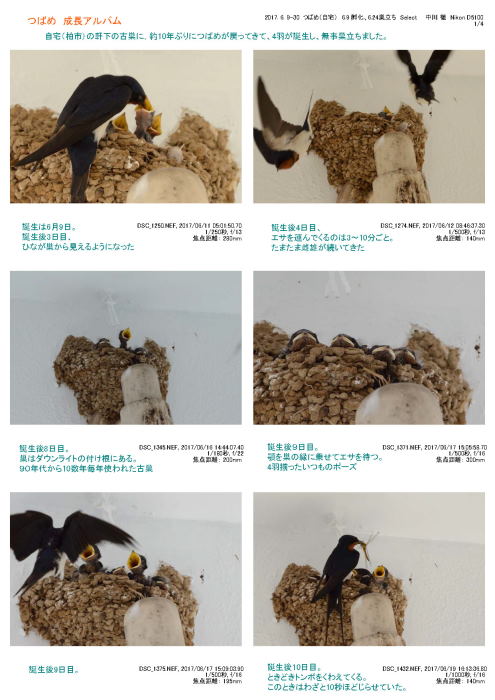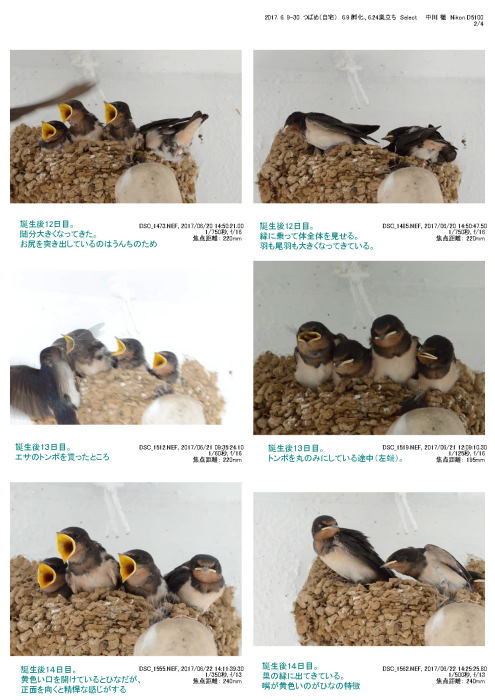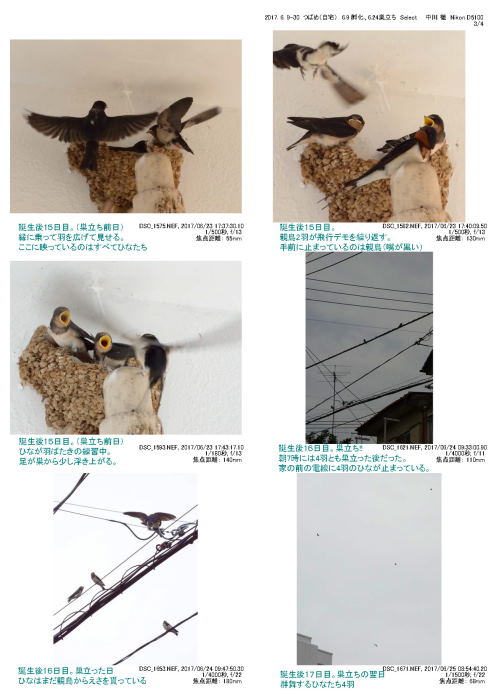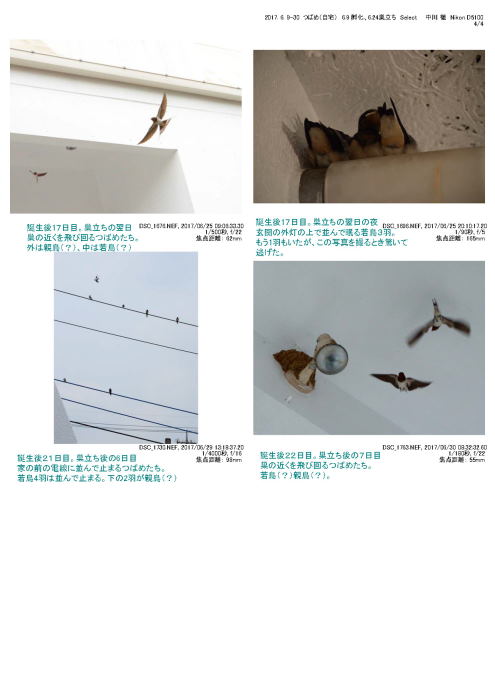Forum: Photo Album
Baby Swallows at My Home
Photo and Edit: Toru Nakagawa
Birth: Jun. 9, 2017; Leaving the nest: Jun. 24, 2017
Posted: Jul. 18, 2017
|
|
Baby Swallows at My Home |
|
|
|
Birth: Jun. 9, 2017; Leaving the nest: Jun. 24, 2017 |
|
Posted: Jul. 18, 2017 |
Press the button for going back to the English top page.
![]() Editor's Note (Toru Nakagawa, Jul. 2, 2017)
Editor's Note (Toru Nakagawa, Jul. 2, 2017)
My home is located in Kashiwa City, about 25 km north-east of Tokyo city center. Fields of rice and vegetables and small woods in the area gradually but constantly turned into houses and shops in these 50 years. From mid 90s to mid 00s, swallows had nested under our eaves and raised youngsters every year. We could not see them for these 10 years or so. To our surprise, a pair of swallows came back to our old nest this year and raised 4 youngsters! I took photos of them everyday through a window of an upstairs closet, directly facing the nest at about 2.5 m. The 4 babies got birth on Jun. 9, and left the nest as young birds on Jun. 24.
An album of 22 photos are posted in PDF (of 4 pages, in Japanese) and also in HTML. You may click the small images to see the enlarged photos. In the top page, 4 selected photos are shown. -- I am very much looking forward to see them again next year.
In PDF (4 pages)
(notes in Japanese)
In HTML (You may click the small images to see the enlarged photos of 700 pixels in width.)
| Jun. 11 | Birth: Jun. 9, 2017 3rd day: |
 |
| Jun. 12 | 4th day: Feeding every 3-10 minutes. |
|
| Jun. 16 | 8th day: A baby with a long neck. |
|
| Jun. 17 | 9th day: 4 baby birds are waiting and waiting for foods. |
|
| Jun. 17 | 9th day: Feeding is usually done quickly |
|
| Jun. 19 | 10th day: Parents bring a dragonfly from time to time. |
| Jun. 20 | 12th day: The babies grow quickly. |
 |
| Jun. 20 | 12th day: Young birds on the nest edge show their whole body. |
|
| Jun. 21 | 13th day: Has got a dragonfly. |
|
| Jun. 21 | 13th day: Swallowing a dragonfly. |
|
| Jun. 22 | 14th day: 3 big yellow mouths like babies, |
|
| Jun. 22 | 14th day: Young birds on the nest edge. |
| Jun. 23 | 15th day (The day before leaving the nest) Young birds spread their wings |
 |
| Jun. 23 | 15th day: Parents demonstrate flying around repeatedly.
|
|
| Jun. 23 | 15th day: A young bird is practicing to flutter the wings, |
|
| Jun. 24 | 16th day: Left the nest! All the 4 young birds left the nest before 7 a.m. |
|
| Jun. 24 | 16th day: The young birds are still fed by their parents. |
|
| Jun. 25 | 17th day: The 4 young birds are flying around high in the air. |
| Jun. 25 | 17th day: Swallows flying around the nest. |
 |
| Jun. 25 | 17th day, evening 8 p.m. 3 young birds sleeping on a door lamp case at my home. |
|
| Jun. 29 | 21st day: |
|
| Jun. 30 | 22nd day: 2 swallows flying around the nest |
|
Last updated on Jul. 18, 2017. Access point: Editor: nakagawa@ogu.ac.jp